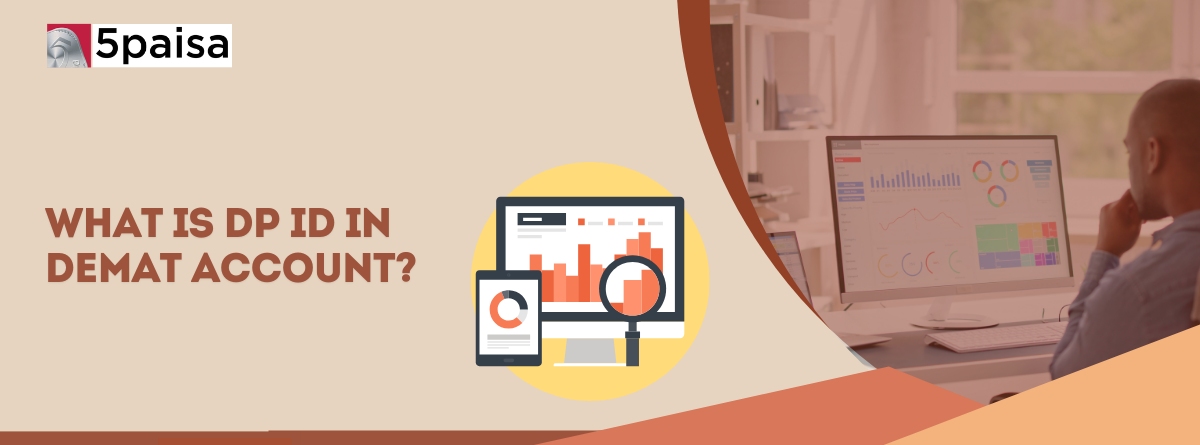What Is DP ID In The Demat Account
5paisa Research Team
Last Updated: 31 Dec, 2024 01:32 PM IST

Content
- What is a Depository Participant?
- Understanding DP ID and its applications
- Example of DP ID in Demat Account
- What is a DP ID in a demat account, and how is it different from a Demat account number?
- Differences between a DP ID and a demat account number
- Understanding CDSL and NSDL
- How to Find Your DP ID?
- Practical Examples and Use Cases of DP ID?
- Indicators for Opening Demat Account
The full form of DP ID is Depository Participant Identification. It is a unique code allotted to a Depository Participant (DP) by an authorized depository. The DP in the demat account plays a significant role in the entire trading process.
Anyone buying and selling securities must know their 16-digit demat account number. The first eight digits of this account number represent the DP ID, which identifies the Depository Participant. The remaining digits constitute the customer ID. Investors need to be aware of both their DP ID and customer ID to effectively use their Demat account for trading securities.
DP ID holds an important role in securities trading as it plays a crucial role in tracking the movement of securities within a demat account. This unique identifier ensures the authenticity of trading activities involving securities. This blog aims to explain the concept of DP (Depository Participant) in a Demat account and its importance in securities trading.
More About Demat Account
- How to Check Your Demat Account Status
- What is Demat Debit and Pledge Instruction(DDPI)?
- Loan Against Shares
- How to Find Demat Account Number from PAN
- How to fill a Dematerialisation Request Form
- Dematerialization of Shares: Process and Benefits
- What Is DP ID In The Demat Account
- What Is Dematerialization of Shares?
- What Is a Demat Account Holding Statement?
- Low Brokerage Charges in India
- How to Choose Right Demat Account – Key Factors & Tips
- Do we need a Demat Account for Mutual Funds?
- Aims and Objectives of Demat Account
- What is BO ID?
- What is a bonus share?
- How to Close a Demat Account
- How to Open Demat Account Without Aadhaar Card
- Open Demat Account Without A PAN Card - A Complete Guide
- Myths & Facts about Demat Account
- What is Collateral Amount in Demat Account?
- What Are DP Charges?
- How to Link Aadhaar Number With Demat Account?
- How to Convert Demat to BSDA?
- Dos and Don'ts of Demat Account
- Difference between NSDL and CDSL
- Advantages and Disadvantages of Opening a Demat Account
- Loan Against Demat Shares- 5 Things to know
- What is NSDL Demat Account?
- NRI Demat Account Opening Process
- What is a Basic Service Demat Account?
- How to Transfer Money from Demat Account to Bank Account
- How to Find Demat Account Number?
- How to Buy Shares through Demat Account?
- How many Demat Accounts one can have?
- Demat Account Charges Explained
- Eligibility to Open a Demat Account
- How to Transfer Shares from One Demat Account to Another?
- Types of Demat Account in India
- Dematerialisation & Rematerialisation: Meaning and Process
- Difference Between Demat and Trading Account
- How to add nominee in Demat Account - A Guide
- How To Use Demat Account? - An Overview
- Benefits of a Demat Account
- Documents Required to Open a Demat Account
- How to Open Demat Account Online?
- What is Demat Account? Read More
Disclaimer: Investment in securities market are subject to market risks, read all the related documents carefully before investing. For detailed disclaimer please Click here.
Frequently Asked Questions
No, sharing your Demat account number with anyone other than registered entity, such stockbroker, CDSL, NSDL, etc., is not safe. unregistered entity may be able to view your portfolio & perhaps execute trades on your behalf if Demat account number is provided with it.
No, client ID, which is final eight digits of 16-digit Demat account number, is same as customer ID. investor's 16-digit Demat account number is made up of first 8 digits, which are DP ID. After Demat account is opened, stockbroker gives Client ID. Investor should be absolute clear about that what is dp id & client id.
The 16-digit DP ID is combination of 8-digit Depository Participant ID & 8-digit Client ID, uniquely identifying demat account for securities trading.



